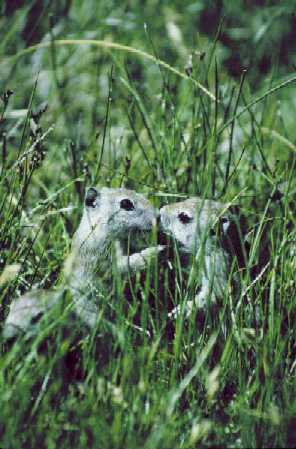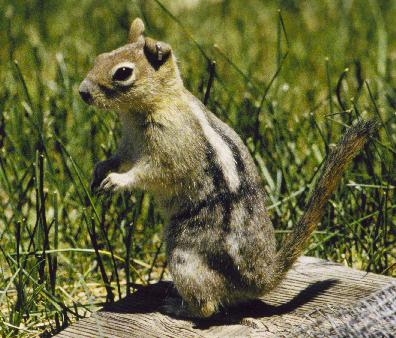

Home
Research Interests
CV & Publications
Teaching
Lab Members
Field Research
Research in the News
Prospective Students
Prospective Field Assistants
Links

Two juvenile Belding's ground squirrels engaged in investigation of oral glands, a recognition behavior

After Porter et al. 1983
Kin recognition and the 'armpit effect'
Animals appear to recognize relatives they have never met
before, but how do they do it? One way is to compare a stranger's traits
to their own (self-referent phenotype matching, dubbed the 'armpit effect'
by Richard Dawkins). When estimating relatedness, whether for directing
nepotistic behaviors or making mate-choice decisions, self-matching may
be more accurate than using the traits of close kin (e.g. parents) as referents.

Two golden hamsters, with the left animal investigating
the flank-gland area of the animal on the right. Photo courtesy of Cornell University News Office.
These odors are produced before young first emerge aboveground,
but are not individually distinct until sometime after emergence, perhaps
because of diet changes associated with weaning and dispersal. Surprisingly,
after nine months of hibernation, ground squirrels do not seem to remember
previously familiar odors, and so must re-establish familiarity with each
other every spring.
Belding's ground squirrels produce two odors can be used as kin labels,
or cues that are more similar among kin than non-kin. There is enough information
in these odors about relatedness that ground squirrels can recognize classes
of distant kin, such as cousins, even though they aren't treated nepotistically.
And, males also produce kin labels and recognize their relatives, even though
they disperse from home and don't engage in nepotistic behaviors.


Juvenile (left) and adult female (right) golden-mantled ground squirrels
Surprisingly, golden-mantled ground squirrels (Spermophilus lateralis), an asocial species which does not show nepotistic behaviors, also produce odors that vary with relatedness. Together, these data suggest that evolution has acted differentially on the production of odors, the perception of odors, and the use of these cues for kin-differentiated behaviors.

On of my research programs involves the proximate mechanisms of social
recognition in mammals. One of my research interests includes how humans recognize one another, and what behavioral (cooperative, competitive) consequences that might have for social interactions.
Another research program involves non-humans. For example, adult female Belding's ground squirrels are nepotistic,
showing preferential treatment toward their close female kin. This includes
the production of risky alarm calls warning of predators, as well as cooperative
defense of territories to prevent infanticide. Yet how individuals recognize
their unfamiliar kin (such as sisters born a previous year) and discriminate
degrees of relatedness has been unclear.
I have been looking at several aspects of chemical communication among individuals,
including the production of distinct odors (e.g. from the oral and dorsal
glands), how these odors are distributed (e.g. indirectly via scent-marking
behaviors or directly via nasal investigations of glands), and what classes
of odors can be discriminated (e.g. unfamiliar paternal half siblings; familiar
non-kin). Belding's have at least five odors that are individually distinct,
and so can be used for individual recognition.
